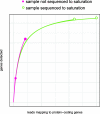Best practices on the differential expression analysis of multi-species RNA-seq
- PMID: 33926528
- PMCID: PMC8082843
- DOI: 10.1186/s13059-021-02337-8
Best practices on the differential expression analysis of multi-species RNA-seq
Abstract
Advances in transcriptome sequencing allow for simultaneous interrogation of differentially expressed genes from multiple species originating from a single RNA sample, termed dual or multi-species transcriptomics. Compared to single-species differential expression analysis, the design of multi-species differential expression experiments must account for the relative abundances of each organism of interest within the sample, often requiring enrichment methods and yielding differences in total read counts across samples. The analysis of multi-species transcriptomics datasets requires modifications to the alignment, quantification, and downstream analysis steps compared to the single-species analysis pipelines. We describe best practices for multi-species transcriptomics and differential gene expression.
Keywords: Best practices; Differential gene expression; RNA-Seq; Transcriptomics.
Conflict of interest statement
The authors declare no competing interests.
Figures




References
Publication types
MeSH terms
Substances
Grants and funding
LinkOut - more resources
Full Text Sources
Other Literature Sources

